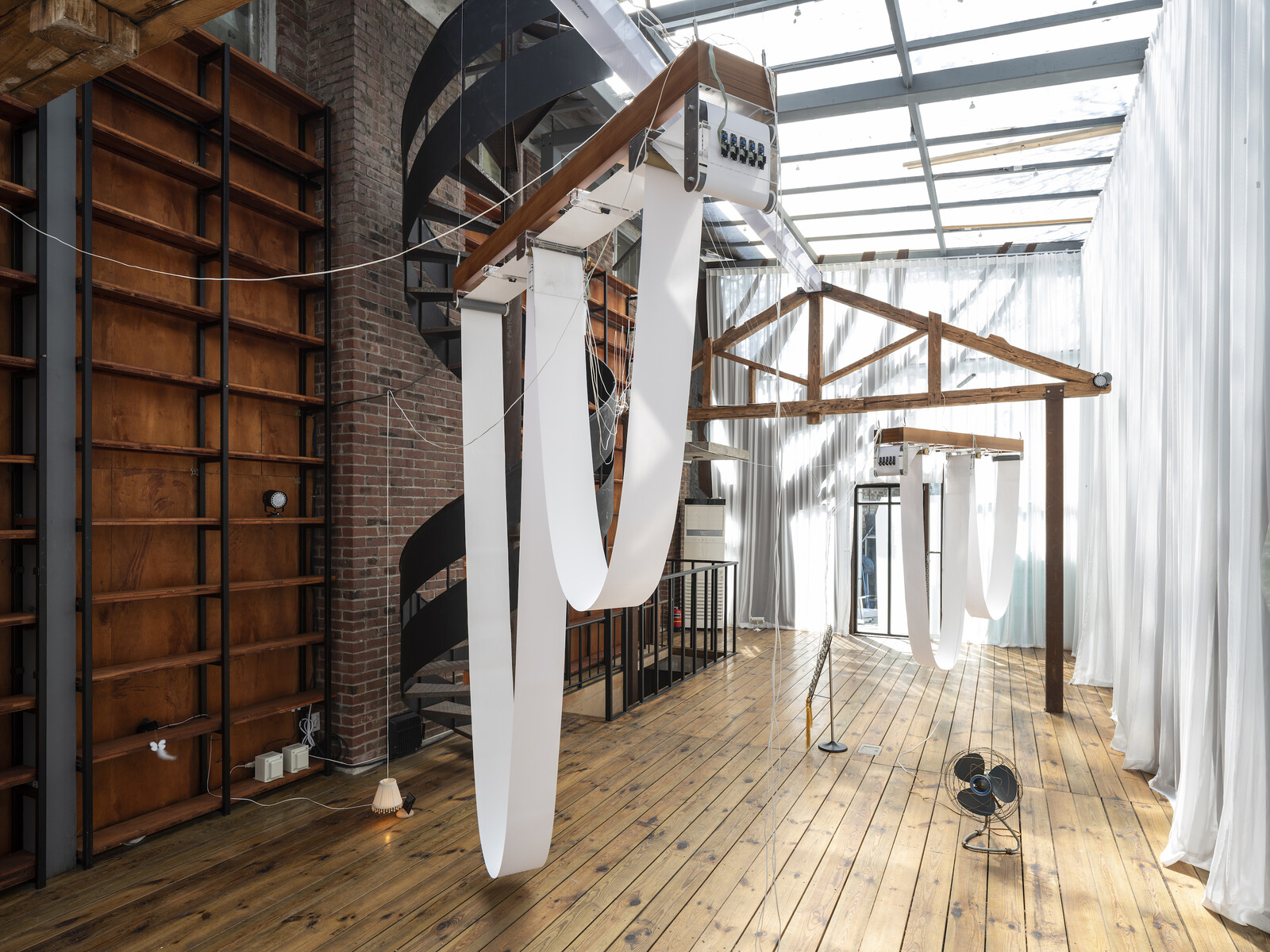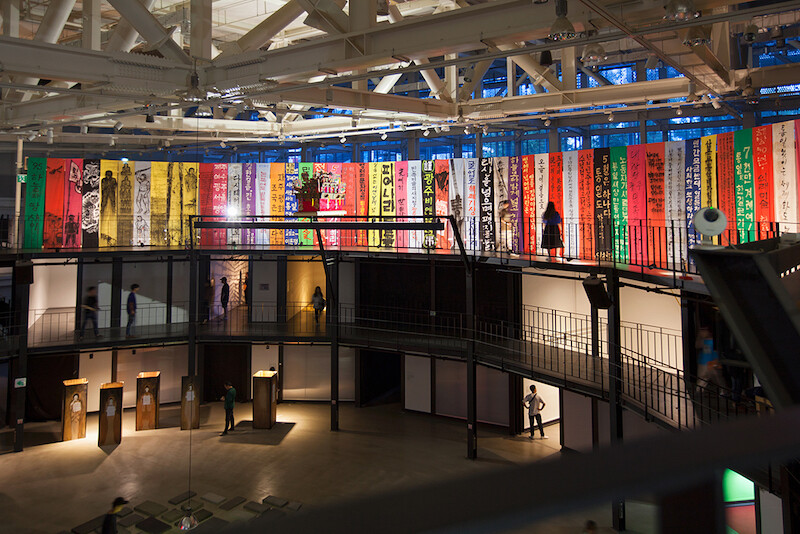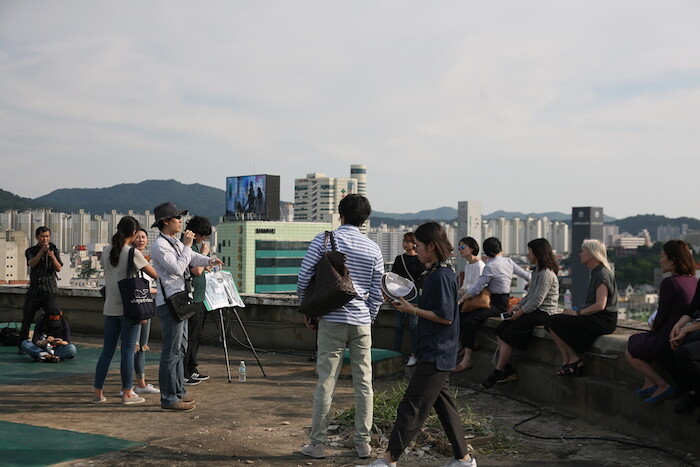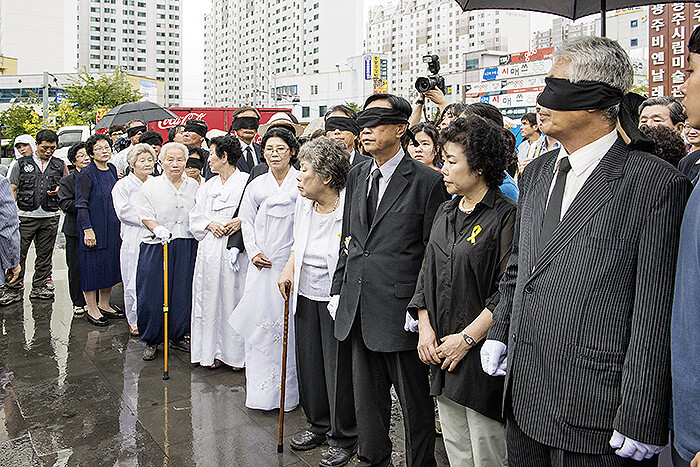Categories
Subjects
Authors
Artists
Venues
Locations
Calendar
Filter
Done
May 12, 2023 – Review
14th Gwangju Biennale, “soft and weak like water”
Jason Waite

The cavernous exhibition hall of the Gwangju Biennale was built in 1994 and intended to host only one exhibition. Walking through the same structure—comprising four mega halls connected by ramps, and still in use by the biennale—feels like exploring an abandoned world expo site. These vast spaces have vexed curators from Okwui Enwezor to Maria Lind, yet this year’s artistic director, Sook-Kyung Lee, has embraced the rickety structure. Instead of constructing new white walls to conceal the building’s decline, Lee and her team have largely left the space as it stands, with the exception of a few partitions of uncut boards and natural-fiber panels.
This sensitivity to exhibition environment carries through a thoughtful, slow-moving show that allows ample space for each work to be considered on its own terms. Reflecting Lee’s artist-centric approach, it’s a relatively intimate biennale: seventy artists, many presenting new commissions. A focus of these is textile installations, which demand a particular attention to their making. I-Lann Yee’s Tepo Putih Ikan Masin (Salted Fish White Mat, 2023) is a hanging composed of woven-together north-Malay mats, typically used for drying fish and in other domestic settings. A colorful, shimmering work, it brings disparate references to mind, including kintsugi …
October 19, 2018 – Review
12th Gwangju Biennale, “Imagined Borders”
Amy Zion

What is art’s role when geopolitical tensions run high and technology makes it difficult—perhaps even irresponsible—to tune out of the perpetual state-of-emergency news cycle that promises, and often delivers, news that impacts the daily lives of people near and far. That’s a reasonable question on many curators’ minds when they are tasked with organizing a large-scale exhibition like a biennale. In Gwangju, the small Korean city’s well-respected biennale, currently in its 12th edition, was concerned with geopolitics from its inception, and the title of the inaugural exhibition was “Beyond the Borders.” It opened in 1995, amid great political change in the Korean government, and the Biennale itself was founded as a memorial to the May 18, 1980 student uprising, which took place in Gwangju. This year’s iteration reflected on that first exhibition, and reopened the theme of “borders” with the title “Imagined Borders.” In April this year, the US-North Korea Summit in Singapore began the discussion to end the war that has divided the Peninsula. And on the weekend of the Biennale’s opening, the South Korean President crossed the Korean Demilitarized Zone for the North’s Independence celebrations, making the exhibition’s title seem more and more like a speech act. However, …
September 5, 2016 – Review
11th Gwangju Biennale, “The Eighth Climate (What Does Art Do?)”
Hanlu Zhang

Hanging right inside the main entrance in Gallery 1, facing incoming visitors, Agnieszka Polska’s Glass of Petrol (2015) is the one work that cannot be missed at the 11th Gwangju Biennale. Depicting a champagne flute filled with shiny gasoline, the colorfulness of which resembles that of Planet Earth, Polska’s digital print hints at humanity’s dependence on oil and opens the Biennale with the image of a world in crisis. The work provides a visual and socio-political backdrop for the question imposed by the curatorial team: “What Does Art Do?”
The other half of the title, “The Eighth Climate,” refers to a concept originating in twelfth-century Persian philosophy: a zone between the material and immaterial, it is both real and imaginal (as distinct from imaginary), resembling the realm of contemporary art. Under this all-encompassing curatorial concept, GB11 features work by 101 artists, including 28 new commissions.
At the center of Gallery 1 is Dora García’s reconstruction of Gwangju’s historic Nokdu Bookstore, said to have fostered the May 18 Democratic Uprising in 1980. Nokdu bookstore for the living and the dead (2016) functions as a real bookstore co-operated by Seoul’s The Book Society. Relevant publications and civilian objects are sold or displayed in and …
September 8, 2014 – Review
10th Gwangju Biennale, “Burning Down the House”
Kevin McGarry

When Jessica Morgan made “Burning Down the House” the title of her Gwangju Biennale, who could have predicted the sinking of the Sewol ferry in April? Or that the censorship of Hong Sung-dam’s mural satirizing South Korea’s President Park Geun-hye—whose administration has been criticized for bungling the crisis and putting too little effort into investigating its causes—would lead to the resignation of Gwangju Biennale president Dr. Yongwoo Lee?(1) Lee was a cofounder of Asia’s oldest biennial back in 1994, so when its 10th edition opened on Friday, one could say the institution itself was indeed ablaze.
Steeped in the somber histories of violence and suppression synonymous with Gwangju, Morgan’s exhibition, as a geopolitical instrument, is an apt backdrop for ruminating on present circumstances and their resonance with the past.(2) Broken into five gallery presentations plumbing facets of the overarching theme, from the house as an architectural figure to fire as a metaphor for transformative unrest, the 103-artist show is also successful as a survey of art. Morgan has tapped a thoroughly international set of voices—from Asia, the West, the South, essentially everywhere—and begins the journey in Korea, in darkness, with Lee Bul’s gritty early performance work made years before she was …
